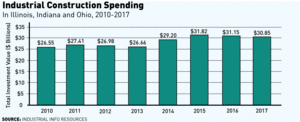
Even as a Gulf Coast construction boom takes shape, one market observer foresees a regional shortage of skilled craft labor in the Great Lakes region and the Midwest when, in the next few years, several big industrial projects ramp up simultaneously.
By 2016, labor demand in the region will rise to 26.8 million worker hours, from 21.9 million worker hours in 2013, says a report from Industrial Info Resources (IIR), a Sugar Land, Texas, construction-market intelligence firm.
It says the demand increase will draw mainly on eight skilled crafts, including welders, pipefitters, electricians and boilermakers. Demand had fallen to 2013's level from 28.17 million worker hours in 2011, says Tony Salemme, vice president of IIR's craft-labor group.
Craft labor utilization rates will be "substantial within certain metropolitan areas," says Salemme.
The largest concentrated rise in demand, which will more than triple by 2016, will be in the Toledo, Ohio, area, he says. That spike "will certainly have an effect on wages and availability throughout the region," he adds.
IIR forecasts especially high labor utilization rates for a few area crafts: 85% for boilermakers, 60% each for electricians and welders and "tight demand" for instrumentation technicians.
These factors could lead to poor retention, high retention bonuses and lower productivity, Salemme says.
Two refinery projects worth more than $5 billion are driving northwest Ohio's expected labor demand.
Husky Energy Inc.'s refinery in Lima and a BP-Husky Refining LLC facility near Toledo are being considered for upgrades to run heavy crude from Canada's oil sands. Husky has approved preliminary engineering for the Lima facility, but a BP spokesman says there is no decision yet about the Toledo project.
If both are in construction from 2015 to 2017, labor needs will contribute to a demand rise in the area to 9.78 million worker hours from the current 3.15 million worker hours through 2015 and keep it above 9.4 million hours in 2016, IIR says. Electricians and welders will be most in demand.

